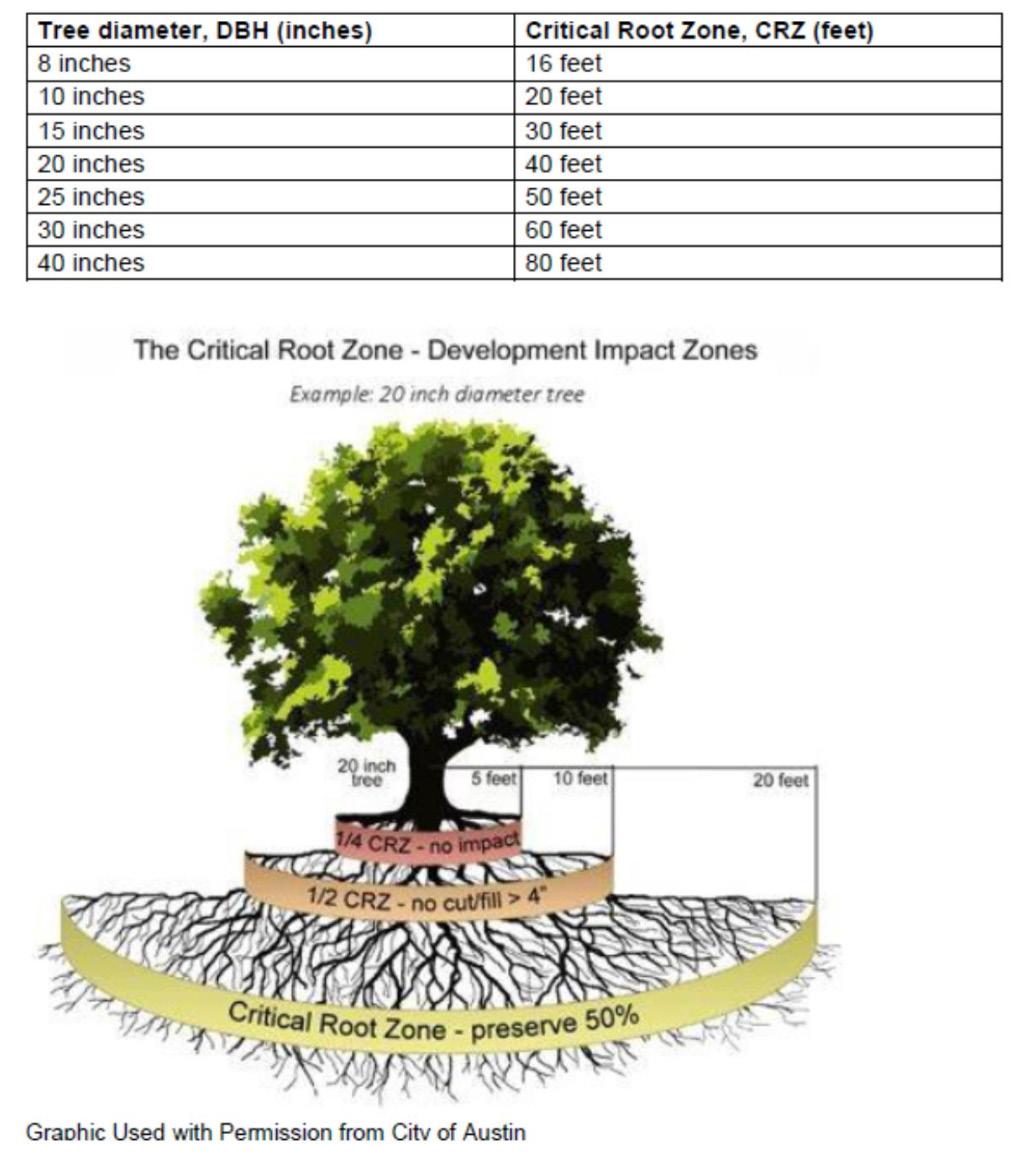
3 minute read
CAMPUS TREE CARE PLAN
tag numbers. If needed, contracted landscape architects and/or arborist shall provide tree inventory data for project area.
2.03.2 All trees 8” DBH and greater on all development sites shall be surveyed and shown on the site plan. Survey criteria shall state tree number, species, and tree DBH, and shall cross-reference existing tree numbers. Any tree survey must be vetted by the contracted landscape architects and/or arborist prior to the issuance of construction documents.
Advertisement
2.04.0 CRITICAL ROOT ZONE DETERMINATION (CRZ):
The contracted landscape architects and/or arborist will coordinate specific requirements regarding scaffolding, construction traffic, build back, forms, foundation, or any other issues as they relate to CRZ. These standards act as the minimum amount of preservation required:
2.04.1 One-foot of radial protection per diameter inch of tree shall determine CRZ (i.e., a 20” tree would have a 40 foot diameter CRZ; see chart below)
2.04.2 Areas:
2.04.21 A quarter of CRZ means no impact is allowed
2.04.22 Half of CRZ means no cut or fill greater than 4” is allowed (i.e., for a 20” tree it would be 20ft in diameter)
2.04.23 Total CRZ needs to be preserved by at least 50%.
2.05.0 TREE PROTECTION FENCING
All trees and natural areas shown on plan to be preserved shall be protected with temporary chainlink fencing. In areas where installation of chainlink fencing would be detrimental to a tree or a tree’s root system, other methods of fencing may be acceptable per approval from contracted landscape architects and/or arborist (i.e., Chain-link panels, plastic fencing, etc.).
2.05.1 Protective fences shall be erected according to UTRGV standards for tree protection.
2.05.2 Protection fencing shall be installed prior to the start of any site preparation work (clearing, grubbing grading) and shall be maintained throughout all phases of the construction project until the final walkthrough is performed unless prior approval is sought through contracted landscape architects and/or arborist.
2.05.3 Tree protection fencing that is damaged or found to be non-compliant shall be repaired/replaced within 24 hours of notice or a stop work order shall be given.
2.05.4 Erosion and sedimentation control barriers shall be installed or maintained in a manner that does not result in damage to the tree or Critical Root Zone (CRZ) and in a manner that does not result in soil buildup.
2.05.5 Protective fences shall surround the trees or groups of trees, and will remain at the location specified in the approved site plan. For natural areas, protective areas shall follow the limit of construction line in order to prevent the following:
2.05.51 Soil compaction in the root zone area as a result from vehicular traffic or storage of equipment and materials.
2.05.52 Root zone disturbances due to grade changes (greater than 4 inches of cut or fill), or trenching not approved or authorized by the contracted landscape architects and/or arborist.
2.05.53 Wounds to exposed roots, trunk or limbs by mechanical equipment.
2.05.54 Other activities detrimental to trees such as chemical storage, concrete clean-outs and other construction spoils.
2.05.6 Exceptions to installing fences at CRZ shall be permitted in the following cases:
2.05.61 Where there is to be an approved grade change, impermeable paving surface, tree well, or other such site development, erect the fence 2 to 4 feet beyond the area disturbed.
2.05.62 Where permeable paving is to be installed within a tree’s CRZ, erect the fence at the outer limits of the permeable paving area (prior to site grading so that the area is graded separately prior to paving installation to minimize root damage).
2.05.63 Where construction activities come within 6 feet of any tree, protection of the trunk with strapped on planking to the height of 8 feet (or the limits of lower branching) may be required in addition to the reduced fencing provided.
2.05.64 Where trees are close to proposed buildings, erect the fence so there is 6 to 10 feet of workspace between the fence and the building.
2.05.65 Where there are severe space constraints due to limits of construction (LOC) or other special requirements contact the contracted landscape architects and/or arborist.
2.05.66 Special Note: For the protection of natural areas, fences are required. No exceptions.
2.06.0 TREE TRANSPLANT SPECIFICATIONS
2.06.1 Trees suitable for transplanting, and their future locations, shall be designated on site plan and marked on site at least six months prior to commencing site preparation activities.
2.06.2 Tree transplant contractor should be allowed at least 90 days lead time for root pruning activities prior to moving trees.
2.06.21 It is recommended that trees be moved between the months of October and February, if possible.
2.06.3 Final grading and elevation of transplant trees shall be confirmed prior to final issuance of construction documents.
2.06.4 Coordination of logistics for movement of transplant trees shall include OFPC, general contractor, engineer, and contracted landscape architects and/or arborist.
2.06.5 Transplanting of trees shall be done in a manner that is industry standard (e.g., time-tested practices etc.). contracted landscape architects and/or arborist shall approve these means and methods









